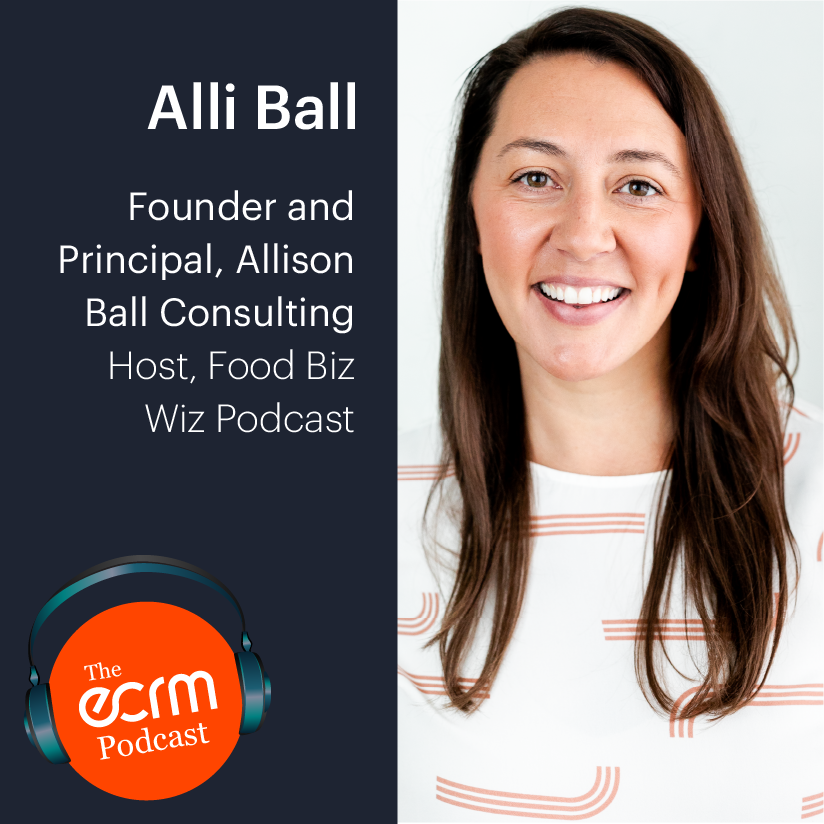5 Steps to a PERFECT Virtual Buyer Pitch 11/4/2020
 Virtual is a part of everyday business now, and is how most buyers are meeting with suppliers these days. And they’re here to stay – even after the pandemic passes. Whether you are meeting with a buyer on your own via Teams or Zoom or if you are participating in ECRM’s Virtual Sessions and Supplier Introductions, it’s important to make sure your game is tight and that you deliver a memorable experience through the screen.
Virtual is a part of everyday business now, and is how most buyers are meeting with suppliers these days. And they’re here to stay – even after the pandemic passes. Whether you are meeting with a buyer on your own via Teams or Zoom or if you are participating in ECRM’s Virtual Sessions and Supplier Introductions, it’s important to make sure your game is tight and that you deliver a memorable experience through the screen.
To discuss how you can CRUSH IT in your next virtual buyer meeting, I spoke with Alli Ball, Founder & Principal of Allison Ball Consulting, who outlined five key steps to holding a perfect virtual buyer pitch.
Ball is a former buyer from award-winning San Francisco-based independent grocer Bi-Rite (I should know, I gave them the award 11 years ago when I was Editor-in-Chief of Progressive Grocer Independent), and for the past several years has been helping emerging food and beverage brands succeed at retail. She’s also host of the Food Biz Wiz podcast, which provides in-the-trenches, practical information for brands.
In this podcast interview, Alli provides details on these five steps to the perfect virtual pitch, which are: identify your WHY; prepare your materials; set the scene; script it out and Practice! Practice! Practice!
I highly recommend listing to the full interview in the podcast or video below, but here’s a summary of the steps, along with some commentary from Ball.
Step 1. Identify your WHY
There has to be a clear, succinct and compelling reason as to “why” the buyer would spend the time and resources needed to bring in your product. And be sure that your “why” is buyer-focused, not consumer-focused. They need to know what’s in it for them.
LISTEN TO THE PODCAST
“It’s common for brands to make the mistake of identifying the wrong why,” says Ball. “They may speak about how delicious the product is, or how sustainably-sourced its ingredients are, and all of that is wonderful, but buyers bring in new products to enhance a particular category in their stores. It’s to increase sales, increase margin, reduce spoilage – typically a numbers-based reason. So if your product doesn’t help the buyer meet specific category goals, it’s not worth the work to bring it in.”
And it can’t just be a simple one-for-one swap, either. Your product must be an improvement over what they already carry in some way. “Let’s say that you make almond butter,” says Ball. “When a buyer says yes to your product, they are making a bet that your almond butter is going to out-sell and out-perform the current almond butter they will be discontinuing to put yours on the shelf. So you have to exceed the current sales velocity of the SKU you are replacing.”
Step 2: Prepare Your materials.
You need to have a sell sheet (or RangeMe profile), price list, and promotional plan that will knock the socks off that buyer. It should include all of the information that buyer could ever need about your brand, how they can order and receive your product, pricing, promotional offers, marketing support, case counts, pallet configurations, distributor information, shelf-life, and so on – all in one shot. Buyers don’t have the time for back and forth emails with a supplier to gather missing information, so you want it to be as complete as possible.
“I’ve seen thousands of sell sheets, and many of them are mediocre, at best,” says Ball. “I was on a webinar with a category manager from KeHE recently who said that they hear pitches for 200,000 products every year, and only bring in about 19,000. So you need to ask yourself, ‘Would your sell sheet stand out in a crowd of 200,000 others?’ That’s how good it needs to be.”
This includes stellar images and product dimensions, as well. The buyer needs to be able to envision what your product will look like on the shelf and whether it would fit in the available space. (Click here for some more details on the value of hi-res 3D product mockups for virtual presentations).
The same applies to RangeMe profiles, which often function as a sales sheet for many brands. Make sure that the profile is complete, includes as many details as possible with descriptive, compelling text, and includes sharp, hi-res images of your products.
Step 3: Set the scene
Your entire world in the buyer’s eyes during a virtual meeting consists of the area in your room or office that’s visible on the buyer’s screen, so make that space work for you. Be creative and be memorable. “One of my Retail Ready clients who makes popsicles actually did her pitch from her freezer, wearing a parka and a fake fur hood,” says Ball. “It was cheeky and wonderful, and definitely stood out.”
Additionally, as I mentioned above, make sure that you have all the basics down tech-wise. Good lighting, audio and a fast Internet connection are table stakes now. Nothing can ruin the flow of a meeting that crappy lighting and a horrible sound. Don’t let bad tech be the reason that a buyer loses interest. For under $200 – less than you’d spend on a flight if you were traveling, anyway – you can get a great webcam, ring light, and podcast mic or headset. Beef up your wifi plan too, while you’re at it. (Click here for some products that Ball recommends on her website.)
For some additional tips on ow to be engaging in front of the camera, you can also check out my interview with three-time Emmy Award-winning journalist Wendy Saltzman.
Step 4: Script it out!
Write out the entire script of your pitch – word for word – with particular attention paid to the opening sentence, the one that includes your WHY. “Most people skip this step,” says Ball. “I always suggest that my Retail Ready students write out the entire script, and use a timer so they can see how long it takes. They can then reduce it down to bullet points as they commit it to memory. This helps you to have a concise and impactful message, reduces the chance of rambling on, and results in the pitch sounding more confident.”
It also helps ensure that you get your pitch completed in enough time to leave room for Q&A with the buyer. To this point, you ay also want to write yourself some answers to frequently asked questions the buyers may ask, so that your answers to those sound confident, as well.
The opening sentence should be designed to get that buyer to sit up a little straighter in their chair, and completely focus their attention on you. One recommendation from Ball is to lead with some relevant data that will grab their attention, such as “Do you know that the gluten-free category is up by 35 percent led by shelf-stable yeast?” (Note – this is just an example, we made up the numbers). It should set up the rest of your pitch.
“Buyers are numbers people, so it’s always good to start with a stat or some data,” says Ball. “So as a buyer, if you told me that your category is trending up, or that your products sell on average six cases a week, that’s something that captures their attention right away.”
The “body” of the pitch should be aimed at providing all of the basic information the buyer needs to help with their decision – consider it your verbal sell-sheet. It should include:
- Sales & category data
- Brief origin story or mission (don’t go too heavy on this)
- Distribution capacity
- Promotions or intro offers: What sort of money are you putting behind your brand?
Above all do not lie or pad information to sound good in the meeting. Be honest about your products and capabilities, because the buyer will eventually find out anyway. Better for them to find out earlier than later.
Step 5: Practice! Practice! Practice!
This may sound obvious, but we can’t overstate the importance of practice. Many of us are new to being in front of the camera, and virtual meetings are much different than sitting across from someone in an office or other meeting space.
“You can get really creative on how your system is set up, but you need to practice with that setup to know what works,” says Ball. “For example, if you are practicing and notice that you have mediocre light or your camera angle is off, you can get a lamp or a ring light and put your laptop on a stack of books if you need to. But you’re not going to know if you need these things unless you practice and do some test runs.”
Fortunately, practice runs are a part of the prep for each participant in ECRM Virtual Sessions. But if you are meeting on your own, it’s important to practice your virtual meting with some colleagues, or even with friends and family. Ask for their honest feedback and incorporate it into your pitch. This way, there are no surprises when it counts.
Also have a backup plan. What if your wifi goes out? Do you have a mobile hotspot you can use? Can you do the meeting from your ipad if there are issues with your computer? In this tech-dependent world, things can happen that are beyond your control, so have a back up plan in place, and practice that as well.
Virtual is here to stay – the efficiencies it delivers are just too great to ignore, so it will remain an essential part of our business even when in-person gatherings are back at full capacity. By following the above steps, you’ll be sure to stand out from the crowd with a memorable and impactful virtual presentation!
About Alli Ball
Alli Ball is a former Grocery Buyer turned Wholesale Consultant, and the creator of Retail Ready, an online course for producers of packaged product in the food industry. Alli has helped hundreds of emerging brands understand what it takes to get their products on the retail shelf - and keep them there - by sharing the behind-the-scenes secrets and thought process of Wholesale Buyers as they assess new products for their stores or online marketplace. Find her on her website, weekly on Food Biz Wiz, her podcast about wholesale strategy, or use her advice daily with her physical planner, specifically made for the packaged food industry.

